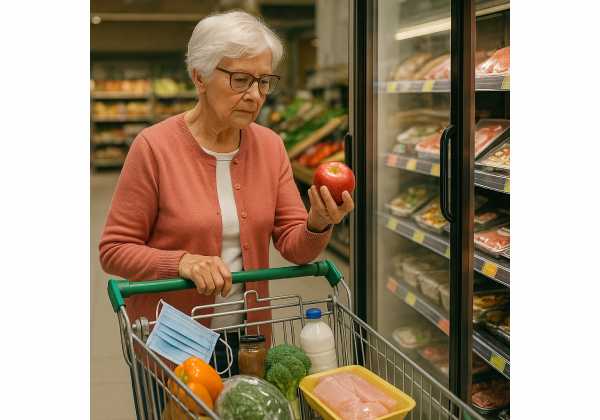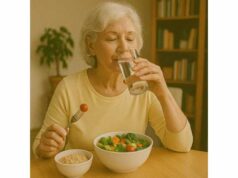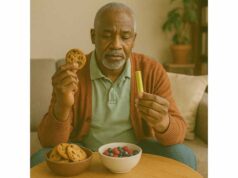
A longer life is a gift—and it is easier to enjoy when foodborne illness stays off the guest list. As we age, immune defenses slow and common medications change how our bodies react to bacteria and viruses in food. The good news: most risk lives in predictable places and can be lowered with a handful of steady habits. This guide translates public-health rules into everyday actions for grocery runs, home kitchens, and travel days. You will find practical temperature targets, keep-or-toss timelines, and simple routines that protect flavor, budget, and well-being. If you want the broader context on how food choices support healthy aging, see our overview of nutrition patterns that promote longevity. For today, keep this aim: buy safely, chill quickly, reheat thoroughly, and enjoy meals with confidence.
Table of Contents
- Why Food Safety Risk Increases with Age and Medications
- Smart Shopping Order and Cold Chain Management
- Fridge and Freezer Temperatures and Storage Time Rules
- Cross Contamination Prevention and Cutting Board Hygiene
- Reheating Temperatures, Microwaves, and Leftover Safety
- High Risk Foods to Limit or Avoid and Safer Alternatives
- Travel and Restaurant Leftovers: Keep or Toss Guidelines
Why Food Safety Risk Increases with Age and Medications
Aging brings strength, perspective, and sometimes a quieter immune response. That slower response can make infections both more likely and more severe. The stomach also produces less acid with age, and stomach acid is one of the body’s first lines of defense against microbes in food. Add common health conditions—diabetes, kidney disease, heart disease—and the risk rises further because illness can dehydrate the body quickly, worsen blood sugar control, and compound existing vulnerabilities.
Medications play a quiet role. Stomach acid–reducing drugs (PPIs, H2 blockers) blunt acid defenses. Immunosuppressants (for autoimmune conditions or after transplants) reduce the body’s ability to fight pathogens. Some diabetes drugs raise dehydration risk if vomiting or diarrhea occur. Even broad-spectrum antibiotics can shift the gut microbiome, altering resilience after exposure to harmful bacteria. None of this means you need a separate kitchen rulebook. It means the basics matter more: temperature control, clean handling, and timing.
Understanding where danger hides helps you act early. The “danger zone”—40°F to 140°F (4°C to 60°C)—is the temperature band where bacteria grow fastest. Two patterns cause most problems at home: food sitting too long at room temperature (picnics, parties, slow cleanup) and undercooked high-risk items (poultry, ground meats, eggs, seafood). A third pattern shows up in leftovers: cooling too slowly or reheating inadequately. Each is fixable with a few habits you can automate: shop in the right order, chill within two hours (one hour in hot weather), and check doneness with a thermometer rather than guesswork.
Finally, symptoms can be atypical in older adults. Instead of obvious vomiting or diarrhea, confusion, weakness, or a sudden drop in appetite may appear first—especially with dehydration. Build a household norm: if food safety is questionable, discard it. Money saved by stretching a suspect dish is not worth the risk of a hospital stay. A simple framing helps: buy cold, keep cold, cook hot, reheat hot, and if in doubt, throw it out.
Smart Shopping Order and Cold Chain Management
Food safety starts before the cart. Your goal is to keep perishable items cold from store to fridge—the “cold chain.” A clear shopping order protects that chain without adding time:
- Shelf-stable first. Grab dry goods, canned foods, grains, oils, and spices early.
- Produce next. Choose whole, uncut fruits and vegetables when possible. If you buy cut produce, ensure it is refrigerated. Bag leafy greens separately from raw meats.
- Dairy and eggs. Pick up milk, yogurt, cheese, and eggs near the end. Check dates and seals; choose pasteurized products.
- Seafood, meat, and poultry last. Place them in separate plastic bags to contain drips. If your store offers frozen meat, consider it for longer, safer transport.
- Frozen foods at the finish. Add frozen vegetables, fruit, and entrees moments before checkout.
Plan for transport. If travel exceeds 30 minutes—or the day is warm—pack an insulated bag with ice packs in your car. Ask for raw proteins to be bagged separately; set them upright in the trunk so packages do not press on produce. Drive straight home. If errands are unavoidable, bring a cooler.
At home, unload perishables first. Designate a clean area to set down raw meats, away from produce and ready-to-eat foods. Wash hands before and after handling packages. Wipe the counter with a food-safe sanitizer or hot, soapy water after you finish. Then decide what goes where: refrigerator now, or freezer for later. Label anything you freeze with the date and a brief description; rotation gets easier when you can see what you have.
Shopping is also the moment to invest in safety tools you will actually use: an instant-read thermometer, appliance thermometers for fridge and freezer, and several shallow containers (2 inches/5 cm deep) for fast cooling. If you batch cook or portion meals after shopping, align this with food safety fundamentals from batch cooking strategies to minimize waste and keep quality high.
Fridge and Freezer Temperatures and Storage Time Rules
Temperature is foundation. Keep the refrigerator at or below 40°F (4°C) and the freezer at 0°F (−18°C). Place an appliance thermometer on a middle shelf in the fridge and between packages in the freezer; check weekly. If temperatures fluctuate (older appliances, crowded shelves), move the thermometer around to identify warmer zones. Store milk and eggs inside the fridge, not in the door, where temperatures swing with frequent opening.
Organize with purpose:
- Top shelves: Ready-to-eat foods (leftovers, cooked meats). Keep them above raw items to avoid drips.
- Middle shelves: Dairy, washed produce, prepared salads.
- Bottom shelf: Raw meat, poultry, seafood in leakproof containers.
- Crisper drawers: Unwashed produce in separate drawers for fruits and vegetables to manage humidity and cross-odors.
Follow storage time rules that reflect both safety and quality:
- Cooked leftovers: 3–4 days in the fridge; freeze portions you will not eat by day two.
- Raw poultry and ground meats: 1–2 days in the fridge; 3–4 months in the freezer for best quality.
- Raw whole cuts (beef, pork, lamb): 3–5 days in the fridge; 4–12 months frozen.
- Fish and shellfish: 1–2 days in the fridge; 3–8 months frozen depending on type.
- Deli meats (opened): 3–5 days; unopened per date, then 3–5 days once opened.
- Soups and stews: 3–4 days in the fridge; 2–3 months frozen.
Cool hot foods quickly to limit time in the danger zone. Divide soups, stews, and casseroles into shallow containers no deeper than 2 inches (5 cm); refrigerate uncovered for 20–30 minutes to release steam, then cover. If you have a large roast, slice before chilling. Avoid stacking hot containers; leave airflow around them for faster cooling. Never leave perishable food out more than two hours (or one hour if above 90°F/32°C).
Keep a “first in, first out” habit. Place new groceries behind older ones. Add a small piece of masking tape with the date on leftovers. Build a weekly “eat-the-fridge” night to use what you have. If a leftover’s date or origin is uncertain, do not taste to test—discard it. The cost of ingredients is far less than the cost of a foodborne infection.
Cross Contamination Prevention and Cutting Board Hygiene
Most kitchens have two invisible highways for bacteria: hands and surfaces. You can block both with simple, repeatable steps.
Hands first. Wash for 20 seconds with soap and warm water before cooking, after handling raw meat, poultry, seafood, or eggs, and after touching trash, pets, or your phone. Dry with a clean towel; damp cloths harbor microbes. Keep a roll of paper towels or clean dish towels within reach so handwashing is convenient.
Separate tools. Use distinct cutting boards: one for raw proteins and another for produce and ready-to-eat foods. Color-coded boards help. If you prefer wood, choose hard, tight-grained types (maple, beech) and keep them well-oiled so liquids do not soak in. Plastic boards can go in the dishwasher; replace them when grooves form that are hard to scrub.
Sanitize right. After raw meat touches a board, scrub with hot, soapy water, then sanitize. A simple kitchen sanitizer is 1 tablespoon (15 mL) unscented liquid chlorine bleach in 1 gallon (3.8 L) of water; let it stand on the surface for one minute, then air-dry. Or use a dishwasher’s sanitize cycle for plastic boards and utensils. Wipe counters with a food-safe product after prepping raw items and again after cooking.
Mind the drip. Store raw meat on a rimmed tray on the fridge’s lowest shelf. When marinating, use a non-reactive container (glass or stainless) and keep it cold; never reuse marinade on cooked food unless you boil it. Use separate plates for raw and cooked meat at the grill. Keep a clean “landing zone” for cooked items to avoid placing them where raw juices were.
Rinse wisely. Do not wash raw poultry—spray spreads bacteria around the sink. Instead, pat dry with paper towels if a recipe requires it, then wash your hands. Do rinse whole produce under running water just before eating or cooking, even when you plan to peel it. For leafy greens, remove damaged leaves and rinse the rest in a colander. Clean your sink after rinsing produce or draining raw meat packages.
If you are updating kitchen habits, pair these routines with broader household changes that support safer cooking, such as the lower-temperature, moist-heat methods discussed in cooking method guides. Doing both reduces pathogen risks and cuts down on over-browning that can harm food quality.
Reheating Temperatures, Microwaves, and Leftover Safety
Leftovers and batch-cooked meals are only as safe as the reheat. Aim for two outcomes: heat the center thoroughly and keep the journey through the danger zone as short as possible.
Know your numbers. Most leftovers should be reheated to an internal temperature of 165°F (74°C). Sauces, soups, and gravies should be brought to a rolling boil. When reheating in the oven, set it to 325°F (163°C) or higher. In the microwave, cover food loosely to trap steam and promote even heating. Let dishes stand for a minute after microwaving; temperatures equalize during this rest.
Stir and rotate. Microwaves heat unevenly. Stir soups and casseroles halfway through. For plates with mixed items, arrange thicker or denser foods (meats, grains) on the outer edge and vegetables in the center. Use a food thermometer to test the thickest part and multiple spots. If your microwave has a turntable, make sure it rotates freely; if not, rotate the dish manually.
Reheat once. Each trip through the danger zone invites growth. Reheat only what you plan to eat. If a large batch is refrigerated, portion into single-meal containers so you can reheat exactly what you need. Return leftovers to the fridge promptly after serving; do not let reheated dishes sit out on the counter.
Defrost with care. Thaw in the refrigerator, in cold water (changing water every 30 minutes), or in the microwave right before cooking. Do not thaw on the counter. If you use the microwave to defrost, cook the food immediately after, because some parts may begin to cook during the thaw.
Rice and pasta deserve attention. Cooked rice can contain spores of Bacillus cereus; cooling rapidly and reheating thoroughly reduces risk. Spread hot rice in a shallow container to chill quickly; reheat to steaming hot. Pasta with creamy sauces spoils faster than tomato-based sauces—watch the 3–4 day rule closely.
If you want to refine reheating while preserving nutrition and texture, pair these steps with ideas from gentle, even-heat techniques that keep food moist without prolonged time in the danger zone.
High Risk Foods to Limit or Avoid and Safer Alternatives
Some foods carry higher pathogen risks, especially for older adults and people on acid-reducing or immune-modulating medications. You do not have to give up favorites entirely; in most cases, a safer version exists.
Higher-risk items to limit or avoid
- Raw or undercooked eggs: Homemade mayonnaise, hollandaise, tiramisu, or runny yolks made with raw eggs. Safer alternative: pasteurized shell eggs or liquid pasteurized eggs for recipes; cook eggs until whites and yolks are firm.
- Unpasteurized dairy: Raw milk, certain artisanal cheeses made from unpasteurized milk. Safer alternative: pasteurized milk and cheeses; check labels for the word “pasteurized.”
- Deli meats and pâtés (unheated): Ready-to-eat meats can harbor Listeria. Safer alternative: heat to steaming hot before eating; buy in smaller amounts and use quickly.
- Raw sprouts: Alfalfa, bean, clover, radish. Safer alternative: cook sprouts thoroughly or choose crisp vegetables like cucumbers or peppers for crunch.
- Raw or undercooked seafood: Oysters, sushi with raw fish, ceviche. Safer alternative: fully cooked seafood; if enjoying sushi, choose vegetarian rolls or those with cooked shrimp or crab.
- Cold smoked fish (unless canned shelf-stable): Safer alternative: hot-smoked or fully cooked fish, or shelf-stable canned versions.
- Unwashed produce or pre-cut fruit held at room temperature: Safer alternative: buy whole when possible; if buying cut fruit, ensure it is refrigerated and consume promptly.
Read labels and ask questions. Look for “pasteurized,” “fully cooked,” and “keep refrigerated.” At the deli counter, ask when items were sliced and how they are stored. In restaurants, request eggs well-cooked and seafood fully cooked unless the establishment can confirm safety practices you trust.
Fermented foods require nuance. Yogurt and kefir made with pasteurized milk and kept refrigerated are generally safe. Raw-fermented vegetables can be safe when made correctly, but salt concentration, temperature, and cleanliness matter. If you enjoy ferments, buy from reputable brands or follow reliable instructions at home. For more on choosing and pairing ferments wisely, see our guide to using yogurt, kefir, kimchi, and miso.
A final rule of thumb: when appetite is low or you are recovering from illness, stick to the safest options—pasteurized dairy, thoroughly cooked proteins, cooked vegetables, and freshly prepared grains. You will nourish recovery without adding risk.
Travel and Restaurant Leftovers: Keep or Toss Guidelines
Meals on the road and nights out deserve extra care because time and temperature control are less predictable. A few choices will reliably keep you safe.
At restaurants
- Ask about doneness. Order eggs well-cooked and meats to safe temperatures (e.g., poultry cooked through, ground meats well-done). If a dish arrives undercooked, send it back to be cooked further.
- Watch the two-hour clock. If you are lingering or the restaurant is warm, plan to refrigerate leftovers at home within two hours (one hour in hot weather). If travel time will exceed that limit, skip the doggy bag.
- Box it promptly. Ask for a container and refrigerate as soon as you get home. Label the container with the date. Eat within 3–4 days or freeze sooner.
On travel days
- Pack a cold kit. Use an insulated bag with two frozen gel packs for airport snacks or car trips. Keep perishables (yogurt, cheese sticks, cooked sandwiches) nestled between packs.
- Choose shelf-stable smartly. Whole fruit, nut butter packets, roasted chickpeas, tuna pouches with crackers, and ultra-high-temperature (UHT) milk boxes are stable without refrigeration until opened.
- Hotel room strategies. Check that the mini-fridge actually keeps items at or below 40°F (4°C); many are beverage coolers. Place a small fridge thermometer inside on arrival. If the fridge runs warm, stick with shelf-stable foods and ice-filled coolers.
Leftovers triage
- Keep: Items refrigerated quickly and reheated thoroughly (165°F/74°C); soups, stews, cooked grains, roasted vegetables, fully cooked meats.
- Toss: Anything left out beyond two hours (one hour in heat); food with uncertain time history; takeout held in a warm car; salads with dairy-based dressings that sat out; seafood leftovers older than a day if not immediately chilled after the meal.
For people who travel often, building a small routine—thermometer for hotel fridges, two gel packs, and a collapsible cooler—turns safety from a worry into a habit. Pair these with restaurant strategies from eating well away from home so your choices support both safety and long-term health.
References
- People at Risk: Older Adults 2024 (Guidance)
- Safe Minimum Internal Temperature Chart 2024 (Guidance)
- Refrigerator and Freezer Storage 2024 (Guidance)
- Food Safety Tips for Dining Out 2025 (Guidance)
- About Norovirus 2024 (Public Health Summary)
Disclaimer
This article provides general food safety guidance for older adults and caregivers. It is not a substitute for professional medical advice, diagnosis, or treatment. Always follow your clinician’s recommendations and local public-health advice. If you suspect food poisoning, seek medical care promptly, especially if you experience dehydration, high fever, blood in stool, prolonged vomiting, confusion, or severe weakness.
If you found this useful, please consider sharing it with friends and family on Facebook, X, or your preferred platform, and follow us for future updates. Your support helps us keep creating practical, trustworthy content.










